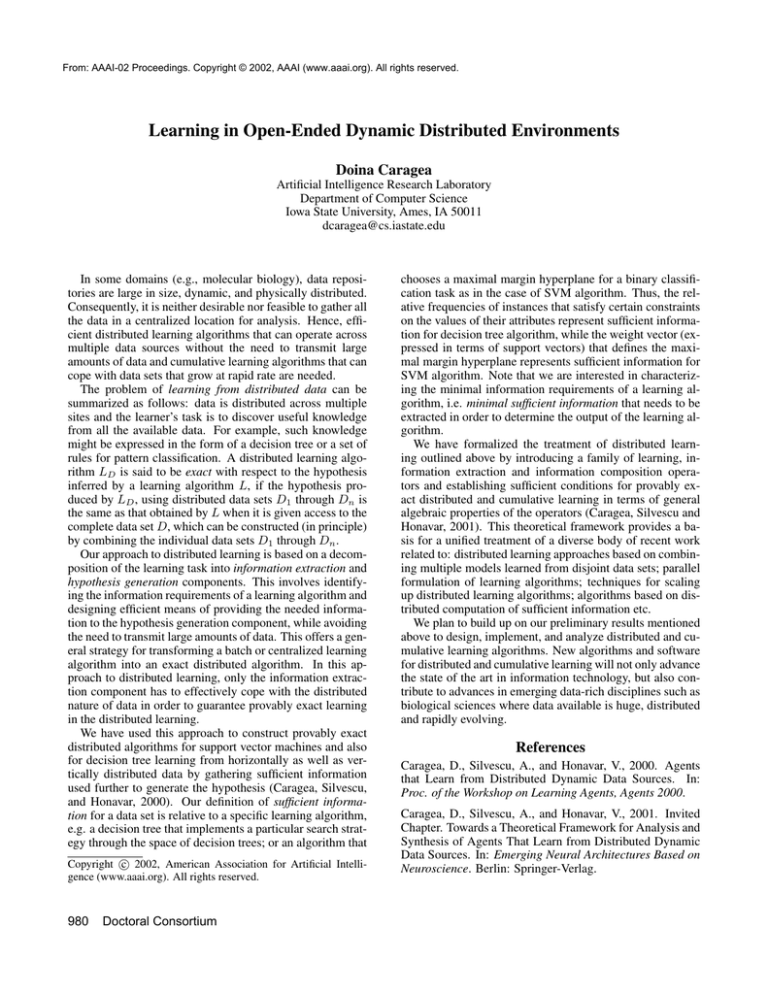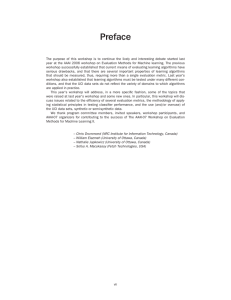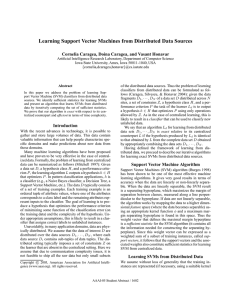
From: AAAI-02 Proceedings. Copyright © 2002, AAAI (www.aaai.org). All rights reserved.
Learning in Open-Ended Dynamic Distributed Environments
Doina Caragea
Artificial Intelligence Research Laboratory
Department of Computer Science
Iowa State University, Ames, IA 50011
dcaragea@cs.iastate.edu
In some domains (e.g., molecular biology), data repositories are large in size, dynamic, and physically distributed.
Consequently, it is neither desirable nor feasible to gather all
the data in a centralized location for analysis. Hence, efficient distributed learning algorithms that can operate across
multiple data sources without the need to transmit large
amounts of data and cumulative learning algorithms that can
cope with data sets that grow at rapid rate are needed.
The problem of learning from distributed data can be
summarized as follows: data is distributed across multiple
sites and the learner’s task is to discover useful knowledge
from all the available data. For example, such knowledge
might be expressed in the form of a decision tree or a set of
rules for pattern classification. A distributed learning algorithm LD is said to be exact with respect to the hypothesis
inferred by a learning algorithm L, if the hypothesis produced by LD , using distributed data sets D1 through Dn is
the same as that obtained by L when it is given access to the
complete data set D, which can be constructed (in principle)
by combining the individual data sets D1 through Dn .
Our approach to distributed learning is based on a decomposition of the learning task into information extraction and
hypothesis generation components. This involves identifying the information requirements of a learning algorithm and
designing efficient means of providing the needed information to the hypothesis generation component, while avoiding
the need to transmit large amounts of data. This offers a general strategy for transforming a batch or centralized learning
algorithm into an exact distributed algorithm. In this approach to distributed learning, only the information extraction component has to effectively cope with the distributed
nature of data in order to guarantee provably exact learning
in the distributed learning.
We have used this approach to construct provably exact
distributed algorithms for support vector machines and also
for decision tree learning from horizontally as well as vertically distributed data by gathering sufficient information
used further to generate the hypothesis (Caragea, Silvescu,
and Honavar, 2000). Our definition of sufficient information for a data set is relative to a specific learning algorithm,
e.g. a decision tree that implements a particular search strategy through the space of decision trees; or an algorithm that
c 2002, American Association for Artificial IntelliCopyright gence (www.aaai.org). All rights reserved.
980
Doctoral Consortium
chooses a maximal margin hyperplane for a binary classification task as in the case of SVM algorithm. Thus, the relative frequencies of instances that satisfy certain constraints
on the values of their attributes represent sufficient information for decision tree algorithm, while the weight vector (expressed in terms of support vectors) that defines the maximal margin hyperplane represents sufficient information for
SVM algorithm. Note that we are interested in characterizing the minimal information requirements of a learning algorithm, i.e. minimal sufficient information that needs to be
extracted in order to determine the output of the learning algorithm.
We have formalized the treatment of distributed learning outlined above by introducing a family of learning, information extraction and information composition operators and establishing sufficient conditions for provably exact distributed and cumulative learning in terms of general
algebraic properties of the operators (Caragea, Silvescu and
Honavar, 2001). This theoretical framework provides a basis for a unified treatment of a diverse body of recent work
related to: distributed learning approaches based on combining multiple models learned from disjoint data sets; parallel
formulation of learning algorithms; techniques for scaling
up distributed learning algorithms; algorithms based on distributed computation of sufficient information etc.
We plan to build up on our preliminary results mentioned
above to design, implement, and analyze distributed and cumulative learning algorithms. New algorithms and software
for distributed and cumulative learning will not only advance
the state of the art in information technology, but also contribute to advances in emerging data-rich disciplines such as
biological sciences where data available is huge, distributed
and rapidly evolving.
References
Caragea, D., Silvescu, A., and Honavar, V., 2000. Agents
that Learn from Distributed Dynamic Data Sources. In:
Proc. of the Workshop on Learning Agents, Agents 2000.
Caragea, D., Silvescu, A., and Honavar, V., 2001. Invited
Chapter. Towards a Theoretical Framework for Analysis and
Synthesis of Agents That Learn from Distributed Dynamic
Data Sources. In: Emerging Neural Architectures Based on
Neuroscience. Berlin: Springer-Verlag.







